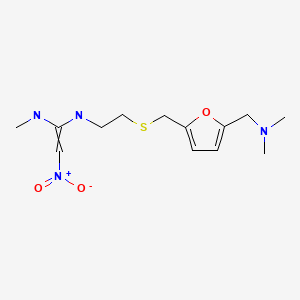CASRN: 66357-35-5

Drug Levels and Effects
Summary of Use during Lactation
Although interpatient variability exists, the dose of ranitidine in breastmilk is less than the dose used in newborn infants. However, the finding that ranitidine spontaneously breaks down to a cancer-causing chemical caused its removal from the market in the US and other countries. Other drugs are recommended.
Drug Levels
Maternal Levels. Six women with established lactation who were 6 to 10 days postpartum were given a single dose of 150 mg of ranitidine orally. Average milk levels were 1.28, 1.42 and 1.02 mg/L at 2, 4 and 8 hours, respectively, after the dose; however, there was great interpatient variability in both peak levels and the time of the peak.[1]
After 5 oral doses of ranitidine 150 mg every 12 hours in a 54-day postpartum woman, the highest measured milk level occurred 5.5 hours after the 5th dose and was 2.6 mg/L. The estimated half-life in milk was 2.9 hours.[2]
Using the average peak milk level data from these 2 papers, an exclusively breastfed infant would receive an estimated maximum of 300 mcg/kg daily with a maternal dosage of 150 mg daily. This dosage is 20% of the dosage used intravenously in newborn infants for stress ulcer prophylaxis.
Infant Levels. Relevant published information was not found as of the revision date.
Effects in Breastfed Infants
One 54-day-old breastfed infant had no observable adverse effects after maternal ingestion of ranitidine 150 mg every 12 hours for 2 days.[2]
Effects on Lactation and Breastmilk
Histamine H2-receptor blockade is known to stimulate prolactin secretion.[3] Ranitidine in intravenous doses over 100 mg or during long-term oral use have increased serum prolactin in some studies, and rare cases of gynecomastia have been reported.[4-8] The prolactin level in a mother with established lactation may not affect her ability to breastfeed.
Alternate Drugs to Consider
Antacids, Cimetidine, Famotidine, Omeprazole, Pantoprazole, Sucralfate
References
- 1.
- Riley AJ, Crowley P, Harrison C. Transfer of ranitidine to biological fluids: Milk and semen. In: Misiewicz J, Wormsley K, eds. The clinical use of ranitidine. Oxford: Medicine Publishing Foundation; 1982:78-81.
- 2.
- Kearns GL, McConnell RF, Jr, Trang JM, et al. Appearance of ranitidine in breast milk following multiple dosing. Clin Pharm 1985;4:322-4. [PubMed: 4039999]
- 3.
- Knigge UP. Histaminergic regulation of prolactin secretion. Dan Med Bull 1990;37:109-24. [PubMed: 2188799]
- 4.
- Perret G, Hugues JN, Louchahi M, et al. Effect of a short-term oral administration of cimetidine and ranitidine on the basal and thyrotropin-releasing hormone-stimulated serum concentrations of prolactin, thyrotropin and thyroid hormones in healthy volunteers. A double-blind cross-over study. Pharmacology 1986;32:101-8. [PubMed: 3081918]
- 5.
- Delitala G, Devilla L, Pende A, et al. Effects of the H2 receptor antagonist ranitidine on anterior pituitary hormone secretion in man. Eur J Clin Pharmacol 1982;22:207-11. [PubMed: 6125393]
- 6.
- Knigge U, Wollesen F, Dejgarrd A, et al. Comparison between dose-responses of prolactin, thyroid stimulating hormone and growth hormone to two different histamine H-2 receptor antagonists in normal men. Clin Endocrinol (Oxf) 1981;15:585-92. [PubMed: 6276054]
- 7.
- Tosi S, Cagnoli M. Painful gynecomastia with ranitidine. Lancet 1982;2:160. [PubMed: 6123872]
- 8.
- Bera F, Jonville-Bera AP, Doustin P, et al. Impotence and gynecomastia secondary to hyperprolactinemia induced by ranitidine. Therapie 1994;49:361-2. [PubMed: 7878608]
Substance Identification
Substance Name
Ranitidine
CAS Registry Number
66357-35-5
Drug Class
Breast Feeding
Lactation
Milk, Human
Anti-Ulcer Agents
Histamine H2 Antagonists
Gastrointestinal Agents
Disclaimer: Information presented in this database is not meant as a substitute for professional judgment. You should consult your healthcare provider for breastfeeding advice related to your particular situation. The U.S. government does not warrant or assume any liability or responsibility for the accuracy or completeness of the information on this Site.
Publication Details
Publication History
Last Revision: September 15, 2024.
Copyright
Attribution Statement: LactMed is a registered trademark of the U.S. Department of Health and Human Services.
Publisher
National Institute of Child Health and Human Development, Bethesda (MD)
NLM Citation
Drugs and Lactation Database (LactMed®) [Internet]. Bethesda (MD): National Institute of Child Health and Human Development; 2006-. Ranitidine. [Updated 2024 Sep 15].